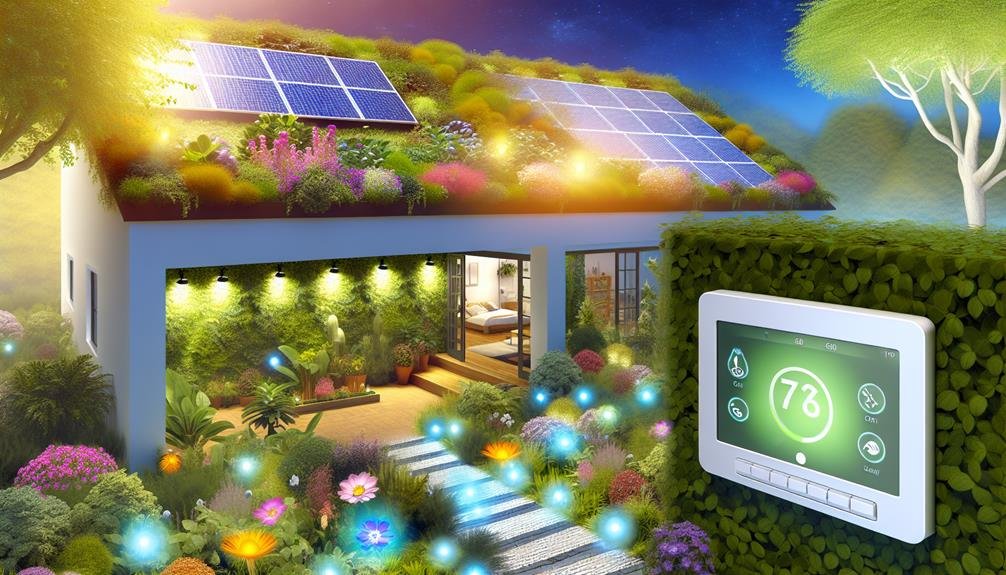Did you know that the average household in the United States emits approximately 20 metric tons of carbon dioxide each year?
With the growing concern for environmental sustainability, many homeowners are turning to smart home automation as a solution to reduce their carbon footprint.
Smart home automation offers a range of energy-efficient and environmentally-friendly solutions that not only help save money but also contribute to a greener planet.
From energy-efficient lighting solutions to waste management through smart technology, the possibilities are endless.
So, imagine if you could make a positive impact on the environment without sacrificing comfort or convenience.
How can smart home automation help achieve this goal? Let's explore further.
Key Takeaways
- Smart home automation offers a range of energy efficiency solutions, including energy-efficient lighting, smart power strips, and smart thermostats, which optimize energy usage and reduce carbon emissions.
- Water conservation can be achieved through smart irrigation systems that customize watering schedules based on plant needs, reducing water waste by up to 50%, and rainwater harvesting, which reduces reliance on tap water.
- Waste management can be revolutionized through IoT-enabled recycling bins that sort recyclables from non-recyclables, smart composting systems that convert organic waste into compost, and reducing waste sent to landfills, thereby reducing greenhouse gas emissions.
- Smart home automation allows for remote control and monitoring of devices, contributing to energy savings, carbon footprint reduction, enhanced security, and improved indoor air quality, creating a more sustainable and comfortable living environment.
Energy-Efficient Lighting Solutions
Switch to energy-efficient lighting solutions for a more sustainable and cost-effective smart home automation. By incorporating natural daylighting techniques and using smart power strips for energy conservation, you can significantly reduce your energy consumption and contribute to a greener environment.
Natural daylighting techniques involve maximizing the use of natural light in your home. By strategically placing windows, skylights, and light tubes, you can illuminate your living spaces without relying solely on artificial lighting. Not only does this reduce your energy usage, but it also creates a more pleasant and inviting atmosphere.
In addition to natural lighting, investing in smart power strips is another effective way to conserve energy. These power strips automatically cut off power to devices when they aren't in use, eliminating standby power consumption. With the ability to control and schedule power usage, you can optimize energy efficiency and reduce your electricity bills.
Smart Thermostats for Optimal Energy Usage
Maximize energy efficiency in your smart home automation by upgrading to smart thermostats for optimal energy usage. Smart thermostats offer several benefits that can help you optimize temperature control and reduce energy wastage.
One of the key features of smart thermostats is their ability to provide remote access and control. This means that you can adjust the temperature of your home from anywhere, using your smartphone or other connected devices. Whether you're at work, on vacation, or simply lounging on the couch, you have the freedom to manage your home's temperature to suit your comfort and energy-saving needs.
By optimizing temperature control, smart thermostats ensure that your home is always at the right temperature, without wasting energy. They can learn your schedule and preferences, and automatically adjust the temperature accordingly. For example, if you typically leave for work at 8 am, your smart thermostat can lower the temperature at that time to save energy. Similarly, it can raise the temperature a few minutes before you usually arrive home, so you walk into a cozy environment.
In addition to remote access and control, smart thermostats often come with energy-saving features such as energy usage reports and smart scheduling. These features allow you to track your energy consumption and make informed decisions about your usage. They also enable you to create customized schedules that align with your lifestyle, ensuring that your home is only heated or cooled when necessary.
Upgrade to a smart thermostat today and take control of your home's energy usage. Enjoy the freedom of optimizing temperature control and reducing energy waste, all with the convenience of remote access and control. With smart thermostats, you can achieve optimal energy efficiency and help protect the environment while maintaining a comfortable living space.
Water-Saving Smart Irrigation Systems
Upgrade your smart home automation with water-saving smart irrigation systems to conserve water and maintain a healthy, beautiful landscape. Here are four reasons why you should consider incorporating these systems into your home:
- Drought-resistant landscaping:
Water scarcity is a pressing issue in many regions. With a smart irrigation system, you can customize watering schedules based on the specific needs of your plants and soil conditions. This ensures that your landscape receives just the right amount of water, reducing water waste and promoting drought resistance.
- Rainwater harvesting:
Smart irrigation systems can be connected to rainwater collection systems. This means that instead of relying solely on tap water, you can use harvested rainwater to irrigate your garden. Not only does this save water, but it also reduces your reliance on municipal water sources, making your home more self-sustainable.
- Real-time monitoring and control:
Smart irrigation systems come equipped with sensors that measure soil moisture levels, weather conditions, and even evapotranspiration rates. This data is used to automatically adjust watering schedules and flow rates, ensuring that your plants receive water only when needed. You can also monitor and control your irrigation system remotely through a smartphone app, giving you the freedom to manage your landscape from anywhere.
- Water and cost savings:
By optimizing water usage, smart irrigation systems can significantly reduce your water bills. According to the Environmental Protection Agency, using a smart irrigation system can save up to 50% of the water used for outdoor irrigation. Additionally, by conserving water, you contribute to the overall sustainability of your community and help protect precious water resources for future generations.
Upgrade your smart home automation with water-saving smart irrigation systems today and enjoy the benefits of a beautiful landscape while conserving water and promoting environmental sustainability.
Waste Management Through Smart Technology
Implementing smart technology in waste management can revolutionize the way we handle and reduce waste, leading to a more sustainable and efficient future. With the advent of IoT-enabled recycling bins and smart composting systems, waste management can be transformed into a seamless and environmentally friendly process.
IoT-enabled recycling bins are equipped with sensors that can accurately monitor and analyze the type and quantity of waste being disposed of. These bins can automatically sort recyclables from non-recyclables, ensuring that waste is properly segregated and sent for appropriate processing. By optimizing the recycling process, these bins can significantly reduce the amount of waste that ends up in landfills, conserving resources and minimizing environmental impact.
Smart composting systems utilize technology to efficiently convert organic waste into nutrient-rich compost. These systems control factors such as temperature, humidity, and airflow to accelerate the decomposition process, resulting in faster and more efficient composting. By diverting organic waste from landfills, these systems not only reduce greenhouse gas emissions but also provide a valuable resource for sustainable agriculture and landscaping.
Reducing Carbon Footprint With Smart Home Automation
By integrating smart home automation systems, you can significantly reduce your carbon footprint while enjoying a more sustainable and energy-efficient lifestyle.
Here are four ways in which smart home automation can help you reduce your carbon footprint:
- Energy monitoring for efficient power consumption: With smart home automation, you can monitor your energy usage in real-time. By identifying energy-hungry devices and understanding your consumption patterns, you can make informed decisions to reduce unnecessary power consumption. This not only helps you save on energy bills but also decreases your carbon emissions.
- Smart appliances for energy conservation: Smart appliances, such as smart thermostats, smart lighting, and smart power strips, can be programmed to optimize energy usage. For example, you can set your thermostat to adjust automatically when you're not at home, ensuring energy isn't wasted on heating or cooling an empty house. Similarly, smart lighting can be scheduled to turn off when not needed, reducing unnecessary electricity usage.
- Efficient resource management: Smart home automation allows you to efficiently manage resources like water and electricity. You can automate your irrigation system to water your garden based on weather forecasts, avoiding overwatering and conserving water. Additionally, you can schedule your appliances to run during off-peak hours, taking advantage of lower energy rates and reducing strain on the power grid.
- Remote control and monitoring: With smart home automation, you have the freedom to control and monitor your devices remotely. This means you can turn off lights or adjust thermostat settings even when you're away from home. By ensuring that devices aren't left running unnecessarily, you can minimize energy waste and reduce your carbon footprint.






